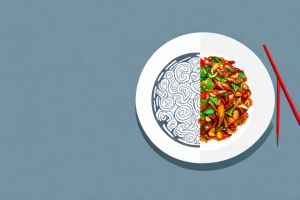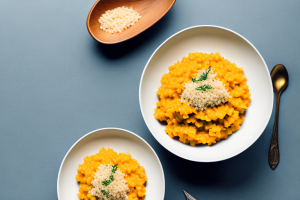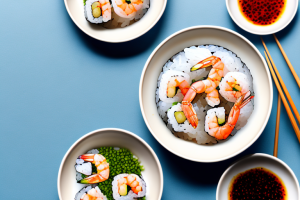How to prepare quinoa rice with black beans
9 min read
A bowl of quinoa rice with black beans
If you’re looking for a healthy and nutritious meal that is also filling and satisfying, you might want to try preparing quinoa rice with black beans. This dish is not only delicious, but also packed with nutrients and easy to make. In this article, we’ll explore the history and health benefits of quinoa and black beans, offer tips on how to select the best ingredients, and provide step-by-step instructions on how to prepare this meal.
The health benefits of quinoa and black beans
Quinoa is a grain that is rich in protein, fiber, and essential amino acids. It’s also gluten-free, which makes it a great alternative for people with gluten sensitivity. In addition, quinoa is a good source of antioxidants, vitamins, and minerals, such as magnesium, potassium, and iron. Similarly, black beans are an excellent source of fiber, protein, and complex carbohydrates, which can help regulate blood sugar levels, reduce cholesterol, and promote digestive health. The combination of quinoa and black beans provides a balanced meal that can help boost energy levels and keep you full and satisfied for longer periods of time.
Moreover, quinoa and black beans are both low in fat and calories, making them an ideal food choice for weight management. They are also versatile ingredients that can be used in a variety of dishes, from salads to soups to main courses. Quinoa and black beans can be cooked together to create a delicious and nutritious vegetarian or vegan meal that is both filling and satisfying.
Furthermore, quinoa and black beans are both sustainable crops that have a low environmental impact. They require less water and fertilizer than other crops, making them a more eco-friendly choice. By incorporating quinoa and black beans into your diet, you can not only improve your health but also contribute to a more sustainable food system.
The history and origins of quinoa and black beans
Quinoa has been cultivated in the Andes of South America for over 5,000 years. It was considered a sacred grain by the Incas and was used in many traditional dishes. Black beans, on the other hand, originated in Mexico and Central America, and have been part of the local cuisine for centuries. Both quinoa and black beans have gained popularity worldwide in recent years due to their health benefits and versatility in cooking.
Quinoa is a highly nutritious grain that is rich in protein, fiber, and essential vitamins and minerals. It is also gluten-free, making it a popular choice for people with celiac disease or gluten intolerance. In addition to its nutritional benefits, quinoa is also a sustainable crop that requires less water and fertilizer than other grains.
Black beans, on the other hand, are a great source of plant-based protein and fiber. They are also low in fat and calories, making them a healthy addition to any diet. Black beans are a staple in many Latin American dishes, such as rice and beans, and are also commonly used in soups, salads, and dips. They are easy to cook and can be seasoned in a variety of ways to suit different tastes.
Tips for selecting the best quinoa and black beans
When choosing quinoa, look for organic options that are free from pesticides and chemicals. You should also check the expiration date and ensure that the grains are clean and dry. As for black beans, it’s best to opt for dried beans instead of canned ones, as the former are less processed and contain fewer preservatives. Before cooking the beans, make sure to soak them overnight and rinse them well to remove any impurities.
Another important factor to consider when selecting quinoa is the color. While white quinoa is the most common variety, there are also red and black quinoa options available. Red quinoa has a slightly nuttier flavor and firmer texture, while black quinoa has a sweeter taste and softer texture. Experiment with different colors to find your preferred taste and texture.
When it comes to black beans, it’s important to note that they are a great source of protein and fiber. However, they also contain a high amount of phytic acid, which can inhibit the absorption of certain nutrients. To reduce the phytic acid content, you can soak the beans for a longer period of time, or even sprout them before cooking. This will not only make the beans easier to digest, but also increase their nutrient content.
Understanding the different types of quinoa and how to cook them
There are several varieties of quinoa available, including white, red, and black quinoa. Each type has a slightly different flavor and texture, but can be cooked using the same technique. To cook quinoa, rinse it first and place it in a pot with twice its volume of water. Bring to a boil, then reduce the heat and simmer for 15-20 minutes, or until the water is absorbed and the grains are tender. You can also add seasonings, such as salt, pepper, or herbs, to enhance the flavor of the quinoa.
White quinoa is the most commonly found variety and has a mild, nutty flavor. It is also the quickest to cook, taking only about 15 minutes to become tender. Red quinoa has a slightly earthier taste and a firmer texture, making it a great addition to salads or as a side dish. Black quinoa has a sweeter, nuttier flavor and a crunchier texture, making it a great choice for adding texture to dishes.
Quinoa is not only a versatile and delicious grain, but it is also packed with nutrients. It is a great source of protein, fiber, and several essential vitamins and minerals. Additionally, quinoa is gluten-free, making it a great option for those with gluten sensitivities or celiac disease. Incorporating quinoa into your diet is a great way to add variety and nutrition to your meals.
How to properly rinse and cook black beans for optimal flavor and texture
Rinsing and soaking black beans is essential to remove any dirt or debris, as well as to reduce the cooking time. Once the beans are soaked, drain the water and rinse them again. Place the beans in a pot with fresh water and bring to a boil. Then, reduce the heat and simmer for about an hour, or until the beans are soft and tender. You can also add spices and herbs, such as cumin, chili powder, or garlic, to give the beans a flavorful kick.
It is important to note that adding salt to the cooking water can toughen the beans and increase the cooking time. Therefore, it is recommended to add salt after the beans have been cooked. Additionally, if you are short on time, you can use a pressure cooker to cook the beans in about 20-30 minutes. However, make sure to follow the manufacturer’s instructions for your specific pressure cooker model.
Combining quinoa and black beans to make a complete protein
One of the benefits of combining quinoa and black beans is that they form a complete protein, which means that they provide all the essential amino acids that our bodies need. This makes the quinoa and black beans duo a great vegetarian and vegan option for people who want to increase their protein intake without consuming meat or dairy products.
Quinoa is also a great source of fiber, which helps to regulate digestion and keep you feeling full for longer periods of time. Black beans are also high in fiber, which can help to lower cholesterol levels and reduce the risk of heart disease.
Additionally, quinoa and black beans are both rich in vitamins and minerals, such as iron, magnesium, and potassium. These nutrients are essential for maintaining healthy bones, muscles, and overall bodily function.
Adding vegetables and spices for a flavorful twist on this classic dish
To make quinoa rice with black beans more flavorful and exciting, you can add a variety of vegetables, such as bell peppers, tomatoes, onions, or corn. You can also experiment with different spices and herbs, such as paprika, oregano, thyme, or cilantro, to give the dish a unique taste. Feel free to be creative and adjust the recipe to your liking.
One great way to add some extra protein to this dish is by including some grilled chicken or tofu. Simply marinate the protein in your favorite spices and grill it up before adding it to the quinoa rice and black beans. This will give the dish an extra boost of flavor and make it more filling.
If you’re looking for a way to make this dish even healthier, consider swapping out the white rice for brown rice or quinoa. These grains are packed with nutrients and will give the dish a nuttier flavor. You can also add some leafy greens, such as spinach or kale, to the mix for an extra dose of vitamins and minerals.
Vegan and vegetarian variations of quinoa rice with black beans
If you’re following a vegan or vegetarian diet, you can easily adapt this recipe to your dietary requirements. Simply omit any animal products, such as meat or cheese, and use vegetable broth instead of chicken broth. You can also add more vegetables or tofu to increase the protein content of the dish.
Quinoa is a great source of protein and is a staple in many vegan and vegetarian diets. It’s also gluten-free, making it a great option for those with gluten sensitivities. Additionally, black beans are a great source of fiber and protein, making this dish a filling and nutritious meal. You can also experiment with different spices and herbs to add more flavor to the dish, such as cumin, paprika, or cilantro.
Serving suggestions for quinoa rice with black beans
Quinoa rice with black beans can be served as a side dish, a main course, or as a filling for burritos or tacos. You can also top it with avocado, salsa, or cheese, and serve it with a side of salad or roasted vegetables.
Storage tips for leftover quinoa rice with black beans
If you have leftovers, you can store them in an airtight container in the refrigerator for up to 3-4 days. You can also freeze the dish for later use, but make sure to thaw it before reheating.
Quinoa rice with black beans as a meal prep option
Quinoa rice with black beans is a great meal prep option, as it can be easily prepared in advance and stored in individual containers for a quick and healthy lunch or dinner. You can also vary the recipe by adding different vegetables or spices.
Nutritional breakdown of quinoa rice with black beans
A cup of cooked quinoa rice with black beans contains approximately 220 calories, 10 grams of protein, 35 grams of carbohydrates, and 4 grams of fiber. It also provides a good amount of essential vitamins and minerals, such as vitamin C, iron, and magnesium.
Quinoa rice with black beans as a gluten-free alternative
If you’re on a gluten-free diet, quinoa rice with black beans is a great alternative to traditional rice dishes, as quinoa is naturally gluten-free and has a low glycemic index. It can help regulate blood sugar levels and provide sustained energy throughout the day.
Quinoa rice with black beans as a budget-friendly meal option
Quinoa rice with black beans is an affordable and budget-friendly meal option, as both quinoa and black beans are relatively inexpensive and easy to find in most supermarkets. You can also buy them in bulk to save more money. By preparing this dish at home, you can also avoid the added cost and sodium of restaurant or fast-food versions.
With these tips and guidelines, you can easily prepare a delicious and healthy quinoa rice with black beans meal at home. Whether you’re looking for a vegetarian or vegan option, a gluten-free alternative, or an affordable and filling meal, this dish has got you covered. Enjoy!


